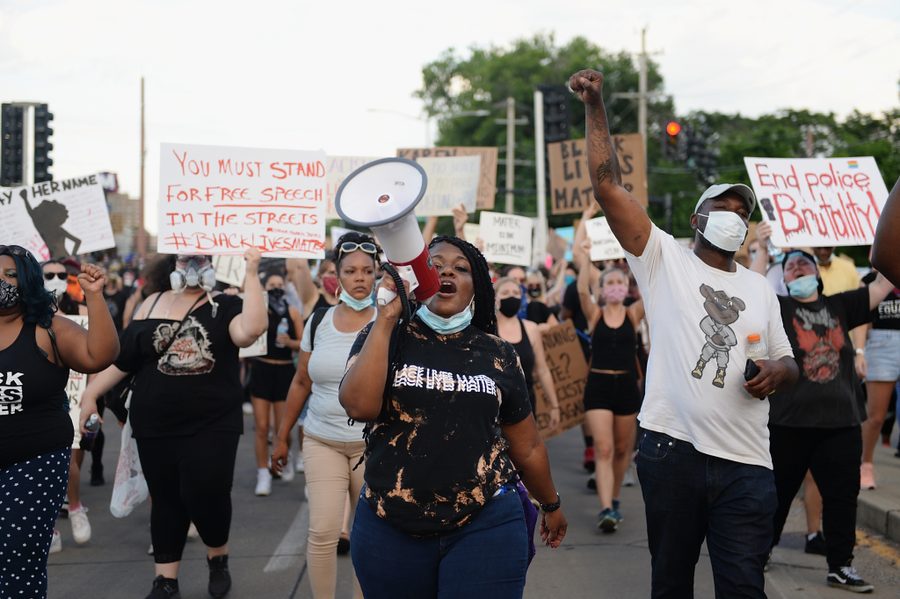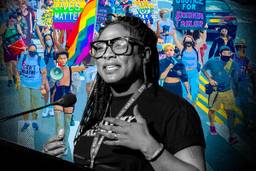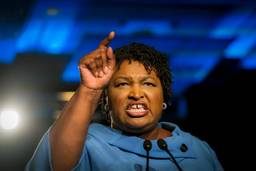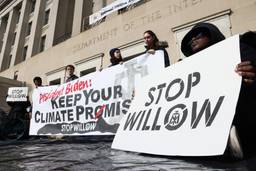The Left Should Double Down on Electoral Organizing
To build power and transform communities, socialists and movement organizers need to engage in the electoral arena.
Alicia Garza

This story is adapted from Power Concedes Nothing: How Grassroots Organizing Wins Elections (OR Books, 2022), edited by Linda Burnham, Max Elbaum and María Poblet. Available now from www.orbooks.com and wherever books are sold.
For the Left, joining electoral organizing to power-building has long been like trying to fuse oil with water. Reform work has often been cast aside for the sake of more revolutionary work, as if the two are not intricately connected. As a result, we have failed to build the power necessary to engage in the revolutionary work that commands so much of our attention.
This has come at great peril, because, to be honest, we’ve not been great at revolutionary work either. Still, too many are searching the past for examples of left transformation, rather than making history ourselves. We should understand how we got here, but it is just as important to study who we are right now, culturally as well as materially. We have to design — and test — new strategies to help us win hearts and minds and contend for many forms of power, including state power.
I have always understood the work of reform to be that of advancing small victories that create more space for survival, and the work of revolution to be that of re-imagining a new economy, society, and democracy that transform all of our lives. These definitions, while perhaps not the most profound, can serve as guideposts to understand how to strengthen our work to achieve the change that we seek.
As we create space for survival, we should not too readily dismiss the impacts of reform work, especially in our current political and social context. Revolution cannot happen without reform — new structures, processes and relationships of power cannot exist absent direct challenges to the current structure.
This is why the failure of the U.S. Left to engage symbiotically with the electoral arena has been so detrimental. Without electoral power, the U.S. Left has little hope of influencing allocation of resources, who represents us, what their agenda is, who shapes the story of who we are and who we can be, and whether actions that counter our agenda will lead to any consequences.
Elections are a vehicle for millions of people to express their desires for their families, their communities and their workplaces. The arena is ripe for left organizing, particularly because of the deepening crises that so many of us experience viscerally each and every day. The United States is undergoing unprecedented changes, from shifting attitudes on policing and racism and the surfacing of white nationalism and white supremacy, to a global pandemic that is shifting our relationships, to ongoing and worsening climate catastrophes.
A viable, responsive, visionary, and grounded Left has never been more necessary. We need to make the changes that we seek legible to millions of people who are desperate for relief, and we need to make clear the path to achieve those changes. Elections are one of many tools that we can use to begin to build the world that we want to see.
From playing defense to building power
Over the last decade, left forces in the United States increased their engagement in electoral organizing, and in 2020 these forces participated in ways not seen in my lifetime. This growth in participation and engagement may be seen as largely defensive, a move to ward off the worst impacts of re-electing a neofascist. Black communities, immigrant communities, and women, along with other marginalized groups, were the targets of backlash from white nationalist forces, joined by corporatist forces, who fought back against the victories won through organizing by those same communities.
Much like the Moral Majority of the 1980s, a new movement emerged that fought to reclaim power and once again dominate the country’s politics, decrying socialism and communism as core threats and using healthcare, asylum, gay marriage, abortion, civil rights, and the election of the first Black president of the United States as core examples of a looming threat to their established way of life.
Finding a leader in Donald Trump, this movement rooted itself in a leap forward in conservative values, what can now be understood as Trumpism. In the 1980s and 1990s the corporate wing of the movement was in the lead, pushing for deregulation, unfettered profit, and global dominance, with China as its core competitor. The religious wing became the mobilizing force that could cement power for the corporate wing, and both largely repudiated the blatantly white supremacist faction.
In the 2000s and 2010s the conservative movement allowed white nationalism to emerge from underground, using it to help mobilize resentment, fear, and anxiety against a convergence of movements that threatens the hegemony and power of the corporatist wing. Faced with increasing economic anxiety from a growing segment of the American population, including white communities, white nationalism was weaponized to distract from the corporate wing’s disastrous economic policies that have driven more and more people into poverty and desolation. This economic anxiety, coupled with demographic change that will render white people a minority for the first time, provided fertile ground for the 2016 election results.
The election of Donald Trump was the culmination of a strategy long utilized by the conservative movement in times of crisis — distract, deter, and dilute the salience of the values and policies that threaten to redistribute power while also changing how power operates.
The Left itself was also transformed. For the last two decades, the U.S. Left has been forced to reckon with race in a new way, none more salient than the push to address and engage with the impacts of racial capitalism and state-sanctioned violence. The rise of U.S.-based racial justice movements like Black Lives Matter, Not One More and others compelled the U.S. Left to move past a tepid racial justice analysis and address race and class simultaneously. Marginalized communities largely led this push and moved the U.S. Left to a reckoning that is transforming the Left itself.
With respect to electoral organizing, segments of the U.S. Left are pushing beyond a strategy of nonengagement to using electoral organizing as defense, with an eye on long-term power building. While still certainly uneven, the engagement of leftists of color in the fight to claim the country’s politics is a significant development — one that must become more than a trend: It must become a lifestyle. In order to build and seize power and transform how power operates, we must take electoral engagement even further to incorporate electoral strategies that shape our larger fights and help us win.
A viable alternative
The organized Left is not alone in its cynicism about politics — the as-yet-unorganized in our communities are rightfully cynical as well, because for decades we have gotten little from politics in its current form. Cynicism among both groups is dangerous, combining “can’t do” with an absence of any alternative vision.
If our communities understood socialism as access to affordable and quality housing, jobs that pay a decent wage, food on people’s tables, or even guaranteed income, everyone would love socialism. But socialism continues to live in the heads of the Left, not in our homes, communities, or workplaces. While this remains true, the conservative movement will continue to succeed in making socialism a boogeyman. Talking about socialism in the abstract, without models or policies that can help win over hearts and minds, is insufficient. This is particularly true in the realm of elections. We must win victories that improve the material conditions of those who receive nothing from politics, and contextualize those wins to help people understand that these are steps toward a new way of governance.
Too often, when we engage in electoral politics we prioritize candidates over organizing. A smattering of progressive or even left candidates, without a strong base that demonstrates a mandate for change, does little to interrupt a political machine that enjoys hegemonic dominance due to lack of a clear, viable and sustained alternative.
When the U.S. Left engages in fights over policy and governance, and advances candidates who will effectively fight to change the rules that have been rigged against us, the result will be tangible changes in the lives of our communities, making change real in practice, not just in theory. It will shift the lives of those left behind by politics — and engage them in the process of changing their own lives.
Fighting for racial justice doesn’t merely mean marching in the streets for justice for those murdered by the police, like George Floyd or Breonna Taylor. Fighting for racial justice, especially in an election cycle, means talking to white communities about the ways in which whiteness is mobilized against their material interests as well as against the interests of communities of color and Black communities. The discomfort with talking about race — or refusal to do so entirely, or bastardizing explicit discussion of race as “divisive identity politics,” especially in an electoral context — undermines our ability to build and transform power. This is particularly so because transforming power must also mean dislodging white supremacy from the structures and policies that govern society.
In the 2020 elections, the Black Voters Matter Fund, spearheaded by LaTosha Brown and Cliff Albright, mobilized Black voters to the polls on what was often dubbed “the Blackest bus in America,” and gave Black communities the tools and resources needed to activate, educate, and organize themselves.
Black Voters Matter Fund understood that it didn’t need to go all in for a candidate in order to get Black communities engaged and involved. Through efforts that were largely nonpartisan, it focused on the issues that mattered most to communities that have been left out and left behind, facing cynicism and legitimate distrust of politics and politicians from Black communities that were used to broken promises.
Perhaps the most significant part of the work was showing Black communities our own strength. Our communities often feel powerless to change our political system, but the Black Voters Matter Fund reminds us that we do have power — especially when we come together and not only make demands but act together in the service of those demands.
That work paid off. Black voters led a multiracial coalition to victory over fascism in the 2020 presidential election. We did it again in January 2021 when two Democrats were elected in Georgia, resulting in a 50 – 50 split in the United States Senate, with the first Black and Indian woman vice president available to cast tie-breaking votes.
Black Voters Matter Fund didn’t spend its time lamenting that Joe Biden and Kamala Harris weren’t good enough. Rather, it turned to building a base of power to which Biden and Harris would have to be accountable.
Breaking through
To build power we must change both policy and culture. Hegemony guides our understanding of right and wrong, belonging and exclusion, who is deserving and who is not. We must prevail in both realms, and elections are an opportunity to do so. “Defund the police” was a counter-hegemonic concept that broke through the conventional wisdom that to challenge law enforcement would undermine a campaign.
Too many on the Left have wrung their hands over how our opposition will use our most visionary demands against us, but too few of us have invested in thinking creatively about how we can use ambitious demands to our advantage. We are at a historical moment of unprecedented skepticism about the ability of police and policing to keep us safe. Instead of retreating from counter-hegemony we should lean in. Defund the Police, Black Lives Matter, Medicare for All, and so many other visionary concepts have captured the hearts and minds of our people, and will continue to do so — but only if we do not back down.
Stories and storytelling are magnificent tools to help people envision what is possible. Stories connect us, helping us to understand one another better and appreciate where we stand in relationship to each other.
Our stories must move beyond reliance on facts and figures — particularly in a world of disinformation and misinformation. In elections, we tell stories about candidates, but we don’t tell stories about communities, and about what makes us a community. We tell stories about what we don’t have and what’s wrong, but we don’t tell stories about what we do have and what we get right when we come together and fight for what’s ours.
Increased engagement by the Left in electoral organizing and power-building efforts is an important shift that, if sustained, could fundamentally reshape this country’s political terrain.
Alicia Garza is an organizer, political strategist, and cheeseburger enthusiast. She is the principal at the Black Futures Lab and the Black to the Future Action Fund, cocreator of #BlackLivesMatter and the Black Lives Matter Global Network, director of strategy and partnerships at the National Domestic Workers Alliance, and host of the Lady Don’t Take No podcast.






